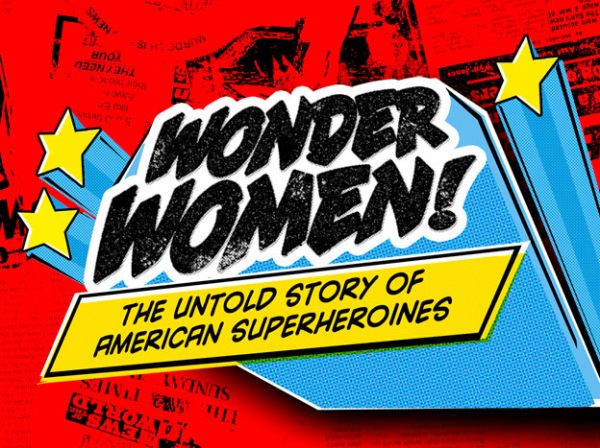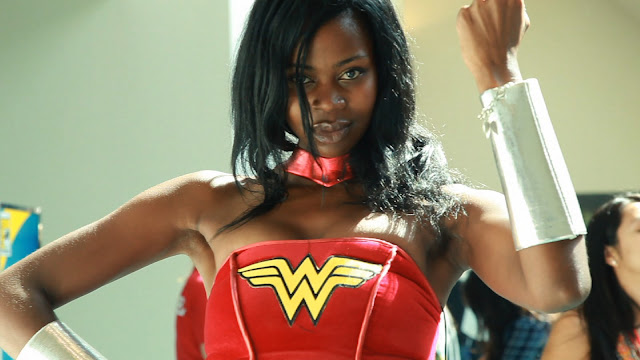Written by staff writer Brigit McCone, this post appears as part of our theme week on Unpopular Opinions.
With D.C. superheroine Wonder Woman recently named UN honorary Ambassador for the Empowerment of Women and Girls and her forthcoming feature film building hype, her profile could hardly be higher as a feminist symbol. Yet Wonder Woman, who the U.N. hopes will focus attention on women’s “participation and leadership,” is an image entirely created by men. She represents, ironically enough, male domination of the struggle against male domination.
William Moulton Marston, who created the ironically iconic Wonder Woman, was an outspoken male feminist who seduced his own student, Olive Byrne, and used her as unpaid domestic labor while living off his feminist wife’s (Elizabeth Holloway Marston) wages. Though feminist cartoonist Lou Rogers has been identified as an inspiration for Wonder Woman’s imagery, it was the male cartoonist Harry G. Peter that Marston selected to draw her adventures. Marston’s disconnect, between the theory and practice of female autonomy, seems reflected in his comic strip’s disconnect between its ideal woman of “Paradise Island” and the real world; it was left to Alice Marble to write a “Wonder Women of History” feature that linked Wonder Woman to the historical achievements of women.
After Marston’s death, a takeover bid by his widow Elizabeth Holloway Marston was snubbed by D.C. Comics, and the strip was handed instead to the sexist stewardship of writer Robert Kanigher, who demoted Wonder Woman from warrior and presidential candidate to babysitter and love advice columnist. Following journalist/activist Gloria Steinem’s promotion of the “Original Wonder Woman” as a feminist icon, a television series — The New Original Wonder Woman (later shortened to Wonder Woman) — was developed by writer Stanley Ralph Ross and producer Douglas S. Cramer (Dynasty).
On his DVD commentary to the pilot, Cramer seems defensively aware of the disconnect between Wonder Woman’s fictional autonomy and her lack of actual female authorship:
“There were very, very few women on the set. The hair, the make-up and the clothes were all done by men… we never had a woman director. There weren’t many women directors out there in those days.”
Yet, back in 1916, Grace Cunard wrote, directed, and starred in the popular adventure serial The Purple Mask, as the swashbuckling Purple Mask who “robbed from the greedy to give to the needy.” Though producer Cramer presents Wonder Woman as progress, claiming, “There really were not a lot of women that were carrying their own shows, and after Bionic Woman and Wonder Woman, that’s when Charlie’s Angels was cast,” it is important to recognize that it is a step backward from a time when Grace Cunard and Alice Guy wrote and directed female action heroes. Are the subtly undermining distortions of a pacifying male-authored feminism not more harmful than an open chauvinism that provokes resistance? Though D.C. courted women directors for their Wonder Woman movie and hired Patty Jenkins, the departure of Michelle MacLaren over “creative differences” suggests that the female director has only limited control. Certainly, she is working within an established legacy that women have not created. Should such semi-liberated sex symbols really be celebrated as ambassadors and stepping-stones to female authorship?
“All Our Hopes Are Pinned Upon You” — Symbolism of the Super-Smurfette
The opening season of Wonder Woman — starring Lynda Carter in the superhero role — is set during World War II, an era of immense importance for women’s rights. While men fought on the frontlines, the women exemplified by Rosie the Riveter proved that they were capable of excelling even in heavy industry, and that factories could accommodate their childcare needs if motivated to do so, with women also serving in military units such as WAVES and WACS. World War II, then, offers Wonder Woman an unparalleled opportunity to ally her efforts with the ongoing triumphs of women across America. Instead, the show is at pains to reduce all other female characters to idiots (the ableist slur “idiot” here describes characters who are themselves stereotypical, ableist caricatures) or deviousness.
In the pilot episode, the on-screen representative of WACS is Marcia (Stella Stevens), depicted as a stereotypically vacant blonde and openly sexual flirt, who reacts to the news that Nazis are planning to bomb the continental U.S. with: “Will that be all, Steve? I have a chiropodist’s appointment this afternoon.” The revelation that Marcia is a Nazi double-agent seems calculated to authorize the beating of this stereotype of brainless blonde sluttishness (again, “slut” here refers to characters negatively depicted as caricatures of devious promiscuity). Cramer hails the pilot’s extended catfight as “a historic moment on television, ’cause I can’t remember any other moments with women fighting women,” citing it as inspiration for equally popular catfights on Dynasty. Other antagonists in the pilot include an older lady with a machine gun and a female taxi driver, while there are no female allies. In later episodes, WACS will be represented by Etta Candy (a feisty ally in the source comics), now a rolling-eyed fool whose incompetence and eating habits are presented as comic relief. Meanwhile, Steve Trevor’s continuous sexist quips are endorsed by Diana’s sighing that he is a “perfect gentleman.”
Wonder Woman constantly struggles to “balance” their positive portrayal of Wonder Woman by viciously misogynistic portraits of all remaining women. The result implies that women have failed to achieve equality only because of their own deviousness or foolishness. Wonder Woman’s heroism is also marked by unattainably extreme perfection, which Lynda Carter admits in her commentary to being concerned by: “People want to be her and they want to be able to identify, and if she’s too perfect…” All women who fail to meet Wonder Woman’s punishing standards are reduced to the level of the catty and unlikable chorus of girls dismissed as “a herd of sheep” in “Miss G.I. Dreamgirl.” Wonder Woman is therefore the ultimate Super-Smurfette, a living embodiment of the Smurfette Principle‘s urge to isolate female achievement. The fact that a television show which encourages girls to feel mocking contempt for all of its female characters, apart from a literal Amazonian goddess, should be hailed as a feminist milestone is as ludicrous as it is tragic.
Margaret Armen, the only woman credited with writing an episode in the first season, introduced the coolly intelligent, highly competent, and villainous Baroness von Gunther as Nazi antagonist. Though she too has a climactic catfight with Wonder Woman, she is notable for not embodying a stereotype of female incompetence or sexual promiscuity. Compare the male-authored episode “Fausta: the Nazi Wonder Woman,” who is yet another evil blonde without detectable personality. Fausta (Lynda Day George) is finally converted to Wonder Woman’s cause, which arguably shows superficial sisterhood but also implies that Fausta has been serving the Third Reich simply because the concept of female bonding had never, ever occurred to her, until she was exposed to the revolutionary banalities of Wonder Woman. The only other female authorship on the show’s first season is that of Barbara Avedon and Barbara Corday, credited with devising the story for Jimmy Sangster’s script of “The Feminum Mystique,” the two-part episode which introduces Wonder Girl (played by a young Debra Winger) to showcase genuine female mentorship. Comparing its female and male authors thus reveals that the male-authored feminism of Wonder Woman is consistently, farcically compromised by its compulsion to isolate its heroine and undermine her female allies.
“In Your Satin Tights, Fighting for Your Rights” — Suffering Sexualized Suffragettes!
Wonder Woman is not only a Super-Smurfette, she is the original Fighting Fuck Toy (FFT). The essence of the Fighting Fuck Toy is her superficial empowerment through “kicking ass,” while being deprived of deeper agency and continually serving as a sexual object for the Male Gaze. Nowhere is this tendency more clearly shown than with Lynda Carter’s Wonder Woman (Diana Prince), a character defined by her hypersexualization from bullet breasts to hot-pants, yet rendered unthreatening to male viewers by her total absence of sexual agency.
The titillation begins with Diana’s introduction, running along the beach with a female friend, giggling in extremely short and gauzy negligees. As Diana later declares to her mother, the Amazon Queen Hippolyta (Cloris Leachman), “There’s something missing, mother. When I look at Steve Trevor, I feel things. Things I’ve never known before,” it is made clear that lesbianism is an unknown pleasure on Paradise Island. It’s wonderful that a Latina woman played the role of a superhero, yet this is an unfortunate missed opportunity for LGBTQ representation, especially with the recent confirmation of Wonder Woman as a queer character in the comics. This means that these women and girls are running around in a state of hypersexualization, not as an expression of any personal sexuality, but in permanent readiness for the arrival of a male viewer. For whom, then, is Paradise Island a paradise? Certainly, male viewers are amply served by the Amazons’ tournament to determine who will accompany Steve to America, an alleged athletic spectacle filmed almost entirely through upskirt shots.
Producer Cramer makes clear not only that Wonder Woman’s sexy appearance was integral to her role, but that the Fighting Fuck Toy’s “ass-kicking” should not be convincing: “If they were a wonderful actress, they approached the job like a lady truck driver.” By “lady truck driver,” he surely refers to the actresses’ ability to appear credibly violent, ruining their titillation by making their empowerment uncomfortably real. The Queen Hippolyta rants against the “barbaric, masculine behavior” of men with comical lust. Yet, Diana’s own lust for Steve will remain demurely unvoiced, as she waits entirely passively for him to take the sexual initiative. This suggests that women’s traditionally presumed passive sexuality is natural and not socially enforced, if even a super-powered and invulnerable woman would never openly express her desires. Furthermore, Diana actively corrects Drusilla (Wonder Girl) when Drusilla comments on a man’s attractiveness. That is, Diana is pointedly shown schooling a younger, sexually outspoken girl into proper passivity and self-suppression, which is enforced by the show as hallmarks of the “good” femininity that distinguishes Wonder Woman from blonde Nazi “sluts.” Lynda Carter expresses regret over Wonder Woman’s lack of sexual fulfillment in the DVD extras: “She didn’t have love in her life and she didn’t have children. I would hope that that story would be told. That’s such a huge part of womanhood.”
“Make a Hawk a Dove, Stop a War with Love” — Make Love, Not Legislation
At the heart of Wonder Woman is the concept that women are essentially different from men, and that female power resides in their essential qualities of love and pacifism. William Moulton Marston went further, and posited submission itself as an integral feminine virtue. In the words of Diana: “On Paradise Island there are only women. Because of this pure environment, we are able to develop our minds and our physical skills, unhampered by masculine destructiveness.” That is, the superpowers of the women of Paradise Island are suggested to be the direct result of their total absence of heteronormative sexuality, and to be incompatible with the presence of men, rooted as they are in a traditional concept of femininity that has historically facilitated male domination. After centuries of disenfranchisement, segregation into the domestic sphere, and being traded as property, male-authored feminism suggests that women can empower themselves by being traditionally feminine harder.
Actual women’s liberation, however, involved riots, incarceration, hunger strikes, occupation movements, clenched fists and even, on occasion, an unattractive shrillness resembling that of a lady truck-driver. Actual liberation involved the collective organization that the Super-Smurfette pointedly avoids. Far from a step forward, Wonder Woman is worse than more simply offensive chauvinism, because it insidiously exploits the female audience’s desire to identify with Wonder Woman’s empowerment. As Lynda Carter puts it: “There’s something about the goddess within, that secret part that resides in every woman, that is a Wonder Woman, that yearns for that independence and strength.” That “secret part” is harnessed by Wonder Woman to push female viewers into aspiring to a failed model of womanhood, one characterized by its hostility to other women, its punishing perfectionism, its sexual passivity and its self-sacrificing submission. Our goddesses within deserve so much better.
[youtube_sc url=”https://www.youtube.com/watch?v=M_blOQEu9ws”]
See also at Bitch Flicks:
Wonder Woman Short Fan Film Reminds Us to Want This Blockbuster
Wonder Women and Why We Need Superheroines
Top 10 Superheroines Who Deserve Their Own Movies
Brigit McCone‘s campy superheroine of choice remains Xena until further notice. She writes short films and radio dramas. Her hobbies include doodling and defending her unpopular opinion that Bloodhound Gang are a witty pastiche of masculinity.









